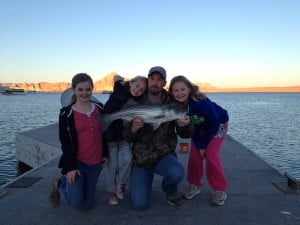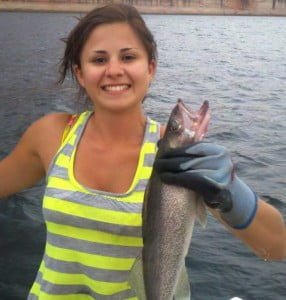Photo Caption: Brett Hepworth and family from
Cedar City UT, found one nice 7-pound striper in Wahweap Bay while fishing over
the President’s Day weekend at Lake Powell. The youngest daughter Whitni caught
the biggest fish.
Lake Powell Fishing Forecast
March 5, 2014
Lake Elevation: 3575
Water Temperature 50-53 F
By: Wayne Gustaveson
Weather is warming and trees are budding in the high desert. It’s time to
start thinking about fishing and what to expect from Lake Powell in 2014.
The lake has dipped to the lowest point since 2005 leaving brushy cover high
and dry on the shoreline. Fortunately there has been modest precipitation in
the Colorado River drainage. When runoff starts the lake should rise from the
currently level of 3575 MSL back to 3600 MSL or perhaps a bit more. Fortunately
the Castle Rock Cut is being deepened and will be accessible to uplake travel
by June 1st. Rising water will rejuvenate many of the launch ramps
that are currently closed including Antelope Point Public and Bullfrog Main
ramp.
Rising water will be good for fish. The old brush line came out of the water
and left brush high and dry when the lake dropped below 3604 MSL. Lake
level exceeding that point will provide cover for bass, crappie and shad that
is needed for good survival of the new year class. Unfortunately, bass
and crappie spawning occurs in late April and May when the lake will be below
the brush line. Therefore, survival of young fish that use brush for cover will
be minimal. Smallmouth bass, walleye and striped bass will have good
production but their population density will depend on how many shad are
produced.
After two seasons of low water levels, total fish numbers are down. Largemouth
and crappie have taken the biggest deduction. Adults remain but there
have been very few young fish recruited to the various fish populations that
anglers seek. The bright spot for shallow shoreline fishing will be smallmouth
bass. They rely on rocky structure for protection and crayfish for
nutrition. In current brushless, low lake conditions smallmouth bass have the
advantage and will be the fish to pursue from March to June.
Smallmouth bass fishing strategy is subtle. With no obvious woody habitat to
target, look for rocky structure with a slope that drops quickly to deep water
or broken rock pile along a slick rock shore. Perhaps the most important
key is to find murky water created by wind or wave action. Most canyons have
muddy water in the back during spring inflow. Look for the color
transitions from clear, to green, to colored, then to
muddy. Smallmouth bass will be found most often between
the green and murky water sections in each canyon. Then look at the rock
structure in the green/murky zone and fish on the shady side of the rock. Yes,
I said it was going to be subtle.
Walleye occupy the same habitat as smallmouth but they feed on a different
schedule. Walleye will be on the shady side of rocks in the muddy/ green zone
but they feed best just before first light and after sunset. They
must have signed a joint use agreement with bass that prevents both from using
the same structure at the same time.
Striped bass were literally jumping in the boat last year looking for the last
anchovy in the bait bucket. A huge population of adult stripers was trapped in
deep water looking for anything to eat. Shad were on the surface and stripers
were in deep water. Those were good memories but put that in the scrapbook and
look ahead. Now that huge population of adults has gone on to bluer
pastures and been replaced by their young offspring. Young, vibrant
stripers in 2014 will be able to feed on the surface and chase shad. Boils may
happen in summer but in the spring look in the backs of main canyons in the
colored water. Troll shallow, mid range and deep runners to find fish.
When a striper is hooked trolling, drop spoons or cast lures as the fish is
played in case the following school comes under the boat. If an inactive
school is graphed while trolling mark the spot with a floating marker and
return with jigging spoons to see if the school will cooperate.
The best trolling lures the past few years were Lucky Craft Pointers, Glass
Shad Raps, and Storm Deep Thundersticks. It is good to have an assortment of
lures but the real key point when trolling is to locate the fish holding
zone. Stripers may hold at a spot on a shoreline where a point extends
into the lake, or over a submerged hump at 30 feet in 60 feet of water or in a
hundred other places. The important point here is to mark the location of
each hookup and immediately return to the exact spot. Many times stripers
can be caught at exactly the same spot while all the water in the immediate
vicinity of the ‘sweet spot’ seems fishless.
Throughout the season my fish reports will highlight these fishing subtleties
and identify hotspots as reported by anglers covering the length of the lake.
If you are lucky enough to find a super fishing spot or a subtle key to
catching fish please report it to me and I will broadcast it in the next
fishing report. Then anglers can use your spot and pay up with their
reports as they leave the lake. Lake Powell is so big it takes a fishing
village to understand it. We invite you all to join the village and share your
insights on Wayneswords.com





